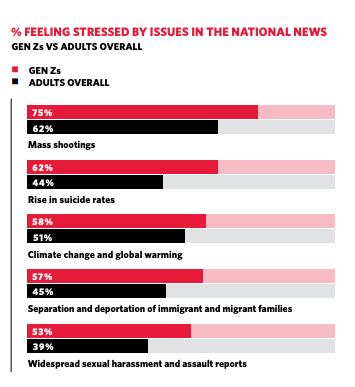Every time a new disheartening statistic is released on teen mental health, I cringe. For the past seven years there’s been a downward trend in the state of their emotional well-being, and I’m waiting—hoping—for an upswing.
The American Psychological Association (APA) periodically surveys for stress in the American public, and since 2013, teens have reported higher levels of stress than adults. In the 2018 APA survey, teens reported worse mental health and higher levels of anxiety and depression than all other age groups.
These finding are consistent with other surveys, and I have yet to see data that counters that trend. A 2019 analysis by Jean Twenge, author of iGen and psychology professor at San Diego State University, showed that between 2005 and 2017, teens and young adults experienced a significant rise in serious psychological distress, major depression, and suicide. And a 2018 American College Health Association survey of more than 26,000 college students found that approximately 40-60% reported significant episodes of anxiety or depression during the year—an increase of about 10% from the same survey conducted in 2013.
Why is there a steady increase in teen distress, when the period of adolescence (as developmental scientists have discovered) is not inherently characterized by “storm and stress?” Adolescence is a period of transformation, not mental illness. So what’s the problem—and what can we do about it?
The popular bogeyman
The most popular focus of blame for teen stress is social media. Is there a connection? On the one hand, it’s certainly obvious that teens (just like the rest of us) spend hours every day staring at screens. And, adolescents are especially sensitive to the social comparisons that result from seeing carefully curated, idealized bodies and lifestyles online. At a panel[i] I recently attended in Berkeley, CA, one eighteen-year-old woman said that she regretted losing so much time in her childhood to wishing that her body looked different. She had come to the conclusion that Instagram and Snapchat “encourage us to live from the outside in, instead of from the inside out.”
In the APA survey on teen stress, one third to one half of teen respondents reported that social media made them feel judged or bad about themselves. In her book iGen, Twenge analyzed large survey data sets and found a correlation between the rise of the smart phone in 2012 and the rise of mental health problems among teens. Her further analyses uncovered similar correlations, explicitly linking more time on new media with more mental health problems for teens in grades 8-12. Conversely, more time spent in in-person interactions (along with sports, homework, religious activity, or print media) correlated with fewer mental health problems.
So, yes, there’s some evidence to support that social media may harm kids. But the situation is complicated. Science and culture zig and zag while scientists test and correct each other’s conclusions, and the correlations between screen use and mental illness have been roundly criticized. One social scientist tweeted that data also shows that “teen pregnancy, drug use, and delinquency all declined significantly with the rise of smartphone and social media use.” In other words, correlation is not causation. It simply means that two things just co-occurred.
A prospective longitudinal study which assesses people over time, sorts out causality better. One such Canadian study surveyed nearly 1,700 teenagers at several points in time up to a six-year period. It showed that social media use did not lead to depression, either in girls or boys. However, the reverse was true: Depression in middle school girls (though not boys) at the beginning of the study predicted greater social media use two years later. In other words, heavy social media use may be a sign for concern, not because it causes distress in the first place, but because it may be a symptom pointing to underlying distress. And middle schoolers may be most at risk.
The longer social media is around, the better youth and families are becoming at managing it. The APA survey on teen stress showed that individual teens use social media in different ways, and it’s worth noting that 55% of teens consider it a source of social support. Parents and teens are also getting better at understanding how social media “hacks” the brain (how the reward algorithms are coded to be maximally addicting). This is especially true in a developing brain, when the reward circuitry and dopamine architecture that “lock in” responses to pleasure are remodeled. As a result, many parents are limiting teen social media use, and numerous guidelines[ii] for wise strategies are now available. Social media “hygiene” is something we should all practice.
Are teens the canaries in the coal mine?
Teens take in more of the outside world than children do. Neurological changes occur in puberty that draw their attention outward, beyond the family, and their cognition allows them to ponder big issues in more abstract and sophisticated ways. Because they take in more and more of the outside world, what teens absorb is increasingly stressful. And high schools reinforce that expanding view with curricula on current social events. Yet teenagers have no prior experience and few strategies for dealing with this new level of exposure.
More than two thirds of adults and teens surveyed by the APA said that the future of the country caused them significant stress and that the U.S. is on the “wrong path.” Teens had additional concerns: 75% of them were stressed about gun violence, mass shootings, and school shootings. This is not surprising given that 288 shootings have occurred in the U.S. since 2009, 57 times the rate of all other developed nations combined. More teens than adults feel stressed by societal issues like rising suicide rates, climate change, immigration separation and deportation issues, and sexual harassment and assault. More teens than adults worry about work, money, and health alongside more age-relevant issues like bullying, peer conflict, gender identity, and sexual orientation.
Stress and adolescence can make for a perfect storm. Until recently, scientists believed that an individual’s baseline for stress reactivity was more or less set in the first two years of life. However, new research suggests that puberty might open that window of sensitivity again for a second chance at recalibrating the stress system—for better or for worse depending on the context: If the environment is supportive in adolescence, this second opportunity might smooth out earlier problems and improve coping in the long run. However, if the context is harsh and stressful without relief or repair, the stress system can remodel for vulnerability and set the stage for later mental and physical health disease systems.
Policymakers should be worried about rising teen stress, not only for the sake of teens’ psychological health (which should be enough cause), but for the health of the country. Teen stress might be an important warning that the nation is off-course. As influential developmental scientist Urie Bronfenbrenner said, “There is no more critical indicator of the future of a society than the character, competence, and integrity of its youth.”[iii] Put more bluntly: If we squander our human capital now, we can’t expect a robust society in the future.
Much of the responsibility for decreasing the stressors listed above is in the hands of policymakers—and ultimately in our hands as voters and citizens. But political and social change take time, and teens and parents are still left to cope. So what might be helpful?
First, remember that every teen is different. Some may find relief, empowerment, and community by actively engaging in planning and organizing around social, political, and environmental issues. Other teens may need to modulate or decrease their exposure to stressful news for self-protection.
Photo by Andrew Lichtenstein:Corbis via Getty Images
Teens benefit from, and want, relationships in which their understanding of the world and their place in it can be co-constructed in a healthy way. A mentoring relationship or facilitated group can help teens process their growing awareness with like-minded people while balancing it with a focus on healthy development. In such a setting, the skills for mastery and sense of control can gradually emerge at a developmentally appropriate pace that teens can manage.
photo credit: E. Frost
Parents might be mindful of buffering their own stress from their teens. True, the parental brain has evolved to scan the environment for threats. But if parents pass on their stress, children can become overly stress-reactive, vigilant, and stress-sensitive. On the other hand, passing on constructive coping strategies is helpful.
Building emotional intelligence skills is always important, too. Every teen will benefit from a) the ability to be aware of their feelings and b) having strategies for regulation. As one woman on the Berkeley teen panel said about meditation, “It’s real. You should try it.”
And finally, a warm family climate and what I like to call a “competing joy” is always a good antidote to stress.
Resurrecting an old theory: Healthy identity development
A third possibility is that society has forgotten about an important developmental task of adolescence.
In the 1960s, while the Baby Boomer generation was famously transforming society, the lifespan psychoanalyst Erik Erikson wrote his groundbreaking work, Identity, Youth, and Crisis, about identity in adolescence.[iv]
Identity is how you walk in the world. It’s a sense of knowing who you are, what you believe, where you fit, and where you’re going. It includes being at home in your body, having personal agency, and feeling a sameness through time, all of which contribute to a general sense of well-being. According to Erikson, and the major developmental scientists who followed, finding a healthy identity is the central task of adolescence.
It takes time. Young children identify with their parents: they imitate them and believe that they’ll grow up to be like them. But with the onset of puberty, neurological and social forces propel teens to differentiate from their parents. (Differentiation is not a rejection of parents, but a reconfiguration of the relationship in order to accommodate a teen’s growing autonomy and independence of thought and action. It’s a necessary process that teens need to go through to become functioning, autonomous adults.)
But teens struggle with their identity and with the core question that adolescence invites them to answer: If I’m not my parent, who am I?
There are multiple paths by which teens find their identities. Whichever they take, Erikson believed that the establishment of a coherent sense of identity requires a period of moratorium—a timeout during which a teen is clearly not a child but the adult path has not been determined. It’s a time to discover and experiment with different roles, paths, ideas, and activities. When a teen quickly changes points of view, jobs, friend groups, pop culture preferences, hair color, and more, this process is likely at work.
The psychologist Jeffrey Arnett, who named the later period of emerging adulthood, said that the central themes to be settled in establishing a healthy identity are worldview, work, and love. The psychologist James Coté believes that identity rests on two things: first, the feeling of having matured into adulthood, and second, finding a permanent niche in community and lifestyle. But exploration can occur across many domains, including politics, religion, societal issues, relationships, recreation, appearance, competence, occupation, morality, ethnicity, sexuality, and intimacy. The process can last a decade or more—usually only one or two areas can be tackled at a time—but it culminates in commitments to those dimensions, a greater sense of purpose, a coherent system of values, and long-term plans. Identity formation—or coming of age—is a central theme of many classic and best-selling novels including The Catcher in the Rye, The Fault in Our Stars, The House on Mango Street, and Jane Eyre.
An authentic identity exploration is hard, intellectually and emotionally taxing. Uncertainty can be uncomfortable, and progress is not linear or orderly. There are anxious periods of not knowing where to fit. Dead ends are common. And progress feels unstable, sometimes sliding back after taking a step forward. It can be difficult for parents to stay supportive as their teens bang around in the mess of options. But identity exploration is most successful when it’s encouraged and accepted by an adult, where the teen feels seen, where their feelings and perceptions can be accurately mirrored back to them, and where they can borrow the confidence, optimism, insight—and sometimes limits—from a loving adult.
According to Erikson, teens should grow into an adult identity, not be forced into one prematurely. But not everyone has that privilege. Some teens are restricted by life circumstances, a lack of options, and/or economic necessity. Others are restricted by self-imposed constraints, or limits others place on them. Erikson said these forced choices do not necessarily lead to a failure of identity: young adults can still organize meaning and purpose out of the circumstance, while still exploring other areas. But he did believe that the lost potential was “regrettable.” Without an authentic search, a teen might not get the chance to discover their true capabilities.
When teens don’t get a chance to explore the central questions of their lives, there can be several problematic outcomes:
A foreclosed identity results from a premature commitment to a path without sufficient exploration or experimentation. This could be the child whose “tiger” mother decided for her in fourth grade that she would be a dancer; the son whose parents forced myriad activities on him in order to build a college resume; or, conversely the child who grew up without any mentor, guide, or exposure to opportunities.
For youth who lack a wide range of opportunities, middle and high schools can offer much-needed exploration and experimentation. In her book, When Grit Isn’t Enough, Linda Nathan argues that career exploration and support should be systematically incorporated into educational curricula from middle school through graduation and across the transition to college.
In their book, Talented Teenagers: The Roots of Success and Failure, authors Mihaly Csikszentmihalyi, Kevin Rathunde, and Samuel Whalen identify the qualities that sustain the development of talent across teen years. Along with a modicum of talent and wholistic support, free time was an important variable. Teens who were distracted with too many life hassles, family conflicts, excessive out-of-school employment, or over-scheduling, did not have the unencumbered time and space that was necessary to just “mess around” in the subject area, to dream, practice, and experiment. Exploring what you’re good at and what you enjoy takes sheer time.
Today, in the drive to raise their selectivity ratings and drive a vast lucrative network of feeder businesses, the college industrial complex colludes to torque teens’ developmental trajectory. Teens (and their parents) often sense a pressure to be a certain kind of idealized applicant, and they’re tempted to shape their high school experiences to fit someone else’s idea of who they ought to be in order to be accepted into college.
Psychologist Robert Sternberg is a forceful critic of college admissions practices. He argues that college acceptance criteria are not correlated with either college achievement or life success. Instead, the types of competencies that predict actual success are: 1) creativity and the ability to see things differently or defy a current trend; 2) wisdom and the application of knowledge and skills for the common good; and 3) practical intelligence and the ability to cope with a situation that’s not explicitly taught, along with more conventional and domain-specific kinds of intelligences.
A diffused identity is one that is never quite settled, in which exploration and experimentation never seem to end. The identity feels incoherent and disjointed, and the individual seems confused about, or just unaware of, who they really are. They’re often more neurotic, have difficulty making decisions, and suffer extreme self-consciousness.
A negative identity is an undesirable one, chosen in opposition to, or defiance of, surrounding pressure. This might be the “bad boy/girl,” the extremist, and the anything-my-father-isn’t person. Erikson observed that a negative identity often arises from a lack of recognition or acceptance from the important person in the teen’s life. In those cases, being somebody “bad” feels better than being nobody at all.
Based on J. Marcia (1980). Identity in adolescence. In J. Adelson (Ed.), Handbook of adolescent psychology. New York: Wiley.
What else is protective against stress?
Some stress is good.
Some parents might overcorrect and try to protect their children from any stress at all. Scientists worry about this kind of experience, too! Parents who “snowplow” or “lawn-mow” away their children’s obstacles do them no favors, in fact, they may be undermining their children’s development. Stress in the right amount promotes neural growth, enhances task performance, and can be a motivation to stretch, reach, and strive.
When young people have a chance to master a new challenge, it can contribute to their resilience, i.e., their ability to withstand and recover from future stresses. Their challenges should be reasonably within their developmental competence; not overwhelming; and “scaffolded” if necessary, where they’re coached through the components. After the challenge has passed, rest and repair also help.
photo credit E. Frost
Mind the basics—sleep, exercise, nutrition.
Teens need more sleep than adults, and they need it later on the clock. A recent survey found that teens are shortchanged by an average of two hours of sleep per night, which adds up to a devastating deficit. Sleep is critical to all areas of functioning. It’s necessary for cognition and consolidating memories, especially in the adolescent period of rapid brain growth. When schools adopt later start times to accommodate teens’ unique sleep needs, the benefits are vast—better mood regulation; improved academic performance; and fewer incidents of conflicts, aggression, bullying, and accidents. Teens, like everyone, should follow good sleep hygiene, including screen-time management. Healthy nutrition and regular aerobic exercise also help keep an even keel.
An authoritative parenting style is extremely protective.
Authoritative parenting balances warmth and love with clear expectations and the support to meet those expectations. It’s flexible, respectful, and allows a teen’s growing autonomy. Of all parenting styles, authoritative parenting is the most predictive of positive outcomes for children and teens.
Other family qualities that help keep teens on track include a positive climate that creates a background sense of well-being, joyful ways of staying connected, and regular routines and rituals. In other words, a thriving family life is nourishing, provides a buffer, and supports resilience. Parents’ own development matters, too; how parents manage their own stress is extremely influential for teens. The template of family life gets imprinted on a teen and stays with them for a very long time.
Photo credits: D. Divecha, Unknown, D. Divecha, S. Burkhart, M. Divecha, R. Archibald
Keep growing the skills of emotional intelligence.
In the APA study of stress, three-quarters of the teens surveyed said they wanted more emotional support. One powerful strategy is to teach them to recognize feelings when they’re happening and help generate constructive strategies (not avoidance and distraction) to regulate them. The more families can name and normalize emotions and emotional competence, the more successfully teens develop.
Save time for friends and relationships.
Good relationships are essential to mental health and well-being. The presence of a caring person can buffer the cortisol response. In the presence of a friend, challenges feel easier to navigate. Unfortunately, teen boys are at risk for giving up their good friends, which can lead to sadness and grief, in addition to an absence of support.
Whatever the cause of adolescent stress, it falls to parents, educators, and mentors to help teens move through it. Developmental science, practical sense, and even traditional wisdom can all help.
When my own daughter (whose father is Indian-American) became a teenager, we marked the new road ahead with a Hindu coming-of-age ceremony. Sitting in the circle of our community and facing my daughter, the pundit reminded her of two things: first, to stay connected to her family, and second, to develop her powers of discernment.
Discernment, the pundit said, is the ability to parse what is true and right from what is not, and it’s one of the most important intellectual qualities. It requires recognizing the difference between what matters to you and what is coming toward you from the world. From that space, wisdom springs.
I’ve enjoyed watching my daughter develop discernment—and use it—as she has formed her identity, choosing a partner, a career, and a new city to live and thrive in. As other parents of grown children can attest, when our teenagers explore their way into the world and land comfortably in a solid identity, it’s a joy for everyone. Nowadays, though, they may just need some extra care doing that.
Copyright 2019 Diana Divecha
[i] Teen Wisdom Panel, April 26, 2019, David Brower Center, Berkeley, CA.
[ii] Common Sense Media; Cyberbullying Research Center
[iii] Bronfenbrenner, U. (1996). The State of Americans: This Generation and the Next. New York, NY: Simon and Schuster, p. 1.











